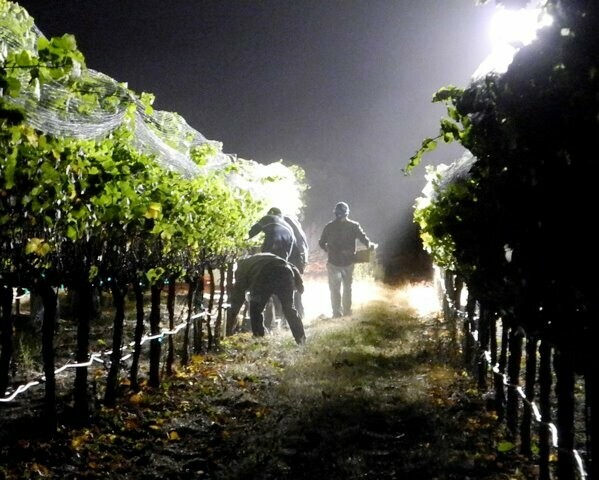News & Articles
Browse all content by date.
 Night farming becomes more common as temperatures heat up.
Night farming becomes more common as temperatures heat up.
If homo sapiens do nothing about climate change, we will be dead saps soon
Animals started to develop from plants 1.8 billion years ago, so that’s when our brains began to develop. The world’s politicians are currently experiencing climate change on every continent but haven’t come up with answers to control it so Homo sapiens can survive on Planet Earth. Our current three pounds of gray matter will not evolve enough to solve it in time. The evidence is overwhelming.
Hamburgers are cooked when they reach 145 degrees. Phoenix, Arizona, has had 31 straight days at 110 degrees or more and has had 55 days at that temp in 2023. A bald man without a cap will get blisters on his head in a few minutes. Concrete and asphalt sidewalks and roads will reach 168 degrees. If the bald guy slips and falls on concrete and can’t get up, he will have second or third degree burns in seconds. More than 425 residents died of the heat in Phoenix in 2022, and 300 have died so far in 2023. Thousands more have had to be treated for heat in hospitals and clinics.
Antarctica is the coldest and driest continent but experienced heatwaves and extreme precipitation in 2022. There has been rapid sea ice decline because temps have been 79 degrees above average March temps. The Conger Ice Shelf, the size of the city of Rome, collapsed. Many upstream glaciers are melting and increasing sea levels. Large areas of the continent have averaged 18 degrees above the averages for the areas.
Charles Darwin, who spent 60 years of his life in the 19th century studying evolutionary biology, which is now the accepted science of the day, recorded this bad news for us about evolving intelligence solving climate-change: “At some stage, the human species will divide. Whilst most will continue to evolve, a minority of those lacking the intellectual capacity of thought, will develop as a sub-species. Being easily led, form into packs attempting to control the majority. They will deny biology, attempt to undo the centuries of human development by re-writing history, and gradually revert to their primate origins. They will expect all to conform to their point of view without question.”
Guess which American political party he is describing.
What can our Congress do to restrict the use of fossil fuels and fund the rapid development of renewable energy sources when one political party in a two-party system is anti-science, thinks climate-change is a hoax, Twitter-x’s the point that a Christian god will not allow the earth to become uninhabitable, has surrendered to greed, and has failed to evolve intellectually?
The Trumplican Party platform reminds me of the Trumper guy who has the Guinness Book of World Records trophy for breaking and smashing 47 toilet seats in a minute with his head. I am not confident that any of our great-grandchildren will see 2300.
Where will five billion people live in 2050?
The United Nations Framework Convention on Climate Change says, “There is a rapidly narrowing window for the world to more quickly cut carbon emissions caused by the burning of fossil fuels and avoid an ever-worsening set of disasters that are likely as the atmosphere grows hotter.”
An analysis by the Washington Post (owned by Jeff Bezos, one of the biggest polluters among the billionaire class with his two superyachts!) and nonprofit CarbonPlan states that, if we don’t mend our ways about renewables and fossil fuels, more than five billion people living in or close to the Tropical Zone will be forced to move to a more comfortable zone by 2050. The group used the threshold of 89.6 degrees Fahrenheit and high humidity, which equals a temperature of 120 degrees. A healthy adult would suffer heat stress if outside for longer than 15 minutes during the day.
Climate-change and environmental scientists say the story of heat is based in economic inequality. About 80% of the world’s population lives in countries where they estimated Gross National Product (GNP) in 2030 will be less than $25,000 per capita. Only 2% will live in countries with a GNP of $100,000 per capita.
While certain parts of rich countries will see heat surges and floods, most of the danger will be in South Asia and sub-Saharan Africa. But this heat epidemic still represents a grave danger to the entire world. Even today people are dying from the heat in farm fields, construction sites, and in facilities without air conditioning. Those workers in the sun are particularly vulnerable to kidney disease, heart attacks, strokes, and mental illness because the body struggles to cool itself by sweating. Even a very light breeze can make the difference between life and death.
So far, there have been eight devastating floods in 11 September-days in Libya, Greece, Turkey, Brazil, Spain, China and Hong Kong. It’s estimated that India, with the world’s largest population, will add 3.3 billion air conditioners to the power grids by 2050. Antarctica sea ice has gone down 36% by 2023 from the 1972-2022 average. Europe lost 63,000 to heat waves in 2022 – and in 2019 the world lost 345,000 people ages 65 and over, to heat waves. For the first time in human history, cooling has become a basic necessity.
Can our world survive if most of the outside work must be done at night?
Dr. Colin Raymond (no relation!) of UCLA added this after the UN study: “Many areas are only slightly below the non-compensable heat level now, so as the planet continues to warm, the total increase in exposure will be exponential. For the most severe events in the coming decades, lives will depend on the availability of artificial cooling.”
The maximum limit of the human body, a wet bulb temperature of 95 degrees, at which even cooling aids cannot take from the body. People in the Persian Gulf India, and China are very vulnerable to extreme temperature and humidity. Scientists have estimated that climate-change has already caused millions of premature deaths in the last three decades and a large portion of the world’s population will be exposed to these non-compensable environmental conditions.
I interrupt this column with BREAKING NEWS! 0n September 11 Storm Daniel in the Mediterranean dropped so much rain on Libya that thousands have died and about 10,000 are missing when two dams broke and flooded several towns. Derna, Libya has suffered 5,300 dead – so far. The Libyan death total may reach 20,000. A 55-year-old man died from the heat while hiking in the Grand Canyon. A half-dozen hikers have died from the heat in other national parks. A storm in China near the city of Maoming flooded the zoo and 69 adult crocodiles escaped from their swimming pool and are harassing citizens. The World Bank is loaning $3.7 billion to fossil fuel companies so drilling can continue in several oil fields around the globe.
Grapes taste better if picked at midnight
Farmers in Asia and Africa are working in their fields at night because their lives would be in danger from heat during the day.
A Washington Post article by Eli Tan and Jacob Bogage “Extreme Heat is forcing America’s Farmers to go Nocturnal” reveals many farmers in the Divided States of America are doing the same thing. Mark Hines, a vegetable farmer in Maryland generally works from 9 pm to 2 am picking tomatoes, melons, pumpkins and lettuce by the light of his headlight. He picks at night because the quality remains better at night. It’s easier to maintain the taste and texture of produce at cooler temperatures and it is cheaper to keep produce cool for shipping. Picking crops at night also reduces sun damage to produce. Produce such as tomatoes, melons, grapes and blueberries have been known to explode on extremely hot days.
California farmers, who produce 80% of the country’s produce, have increased picking costs because they often have to supply ice vests to pickers, provide headlights to pickers at night and buy specially equipped machines to harvest produce at night. Farmers agree that heat is the enemy of quality produce. However, many farmers have had the experience of picking fruit for 24 hours a day in the fall when frost threatens the crop. Peaches are also often picked at night during very hot days because they are firmer when cool.
Apples are a particular problem because when the temperature reaches 88 degrees the trees are sprayed with water for hours to cool them down. They cannot be picked while being sprayed, so farmers will start picking at 2 am to get a full day of picking. Another expensive problem. Special LED floodlights designed to reflect off the natural colors of the apples must be used.
Working in the dark creates more dangers for workers regardless of the crop. Workers have been bitten by poisonous snakes while picking crops because they can’t be seen in the dark. Ladders even create a special problem at night.
What are chances Homo Sapiens will make the planet livable? '
Chances are slim to none – and Slim is out of town looking for lost glaciers. It seems billionaires with superyachts and lots of shares in fossil fuel corporations don’t give a damn. Some of them may think the earth is flat so they will just sail to the horizon and drop off.
ExxonMobil Corporation’s scientists in the 1970s predicted that the company’s fossil fuel products could lead to global warming. That evidence is on paper. What did the company do? It immediately funded various groups and think tanks to start a campaign to deny climate-change – and continued to pump oil in ever-increasing amounts for decades.
If ExxonMobil had started to move to renewables such as nuclear, solar and wind the world would not be in hospice today.
Historian and geographer Jared Diamond has spent a lifetime studying why societies and empires have died in the last 13,000 years. In his 2005 bestseller How Societies Choose to Fail or Succeed, he describes why the almost great American empire and society will not make it. He lists climate-change ignorance as the primary reason, but he lists eight other associated reasons why we will not succeed in modifying temperatures around the world:
(1) Deforestation and habitat destruction
(2) Erosion, salinization and soil fertility losses
(3) Water management problems
(4) Overhunting
(5) Overfishing
(6) Foreign species feast on native species
(7)Overpopulation
(8) Increased per-capita expenses for members of the society.
In his book he identifies three major factors why civilizations fail – and why the Divided States of America and most countries in the world are guilty:
1. A persistent pattern of environmental change for the worse like long-last droughts, signs that existing modes of agriculture or industrial production were aggravating the crisis
2. The failure of elites and billionaires to abandon harmful practices and adopt new means of production
3. A critical threshold is crossed and collapse invariably follows. He is telling us the threshold has been crossed and the environmental damages of climate-change are now unavoidable and getting worse by the year.
Slim hasn’t found any glaciers yet.
| Tweet |


